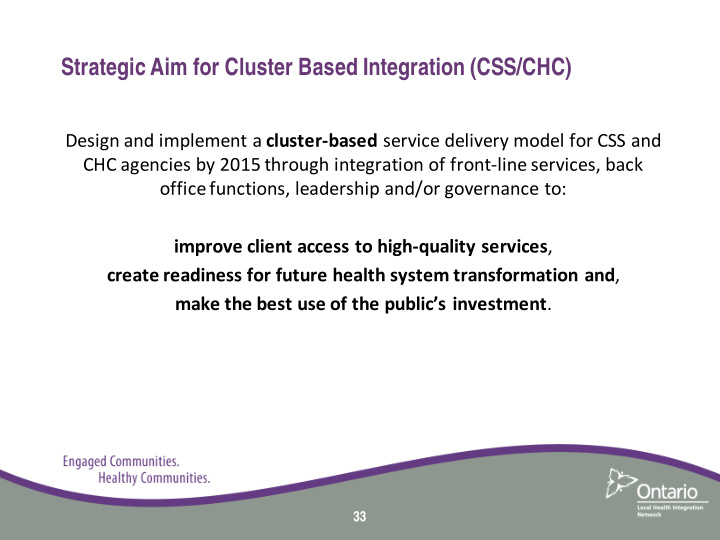



Strategic Aim for Cluster Based Integration (CSS/CHC) Design and implement a cluster-based service delivery model for CSS and CHC agencies by 2015 through integration of front-line services, back office functions, leadership and/or governance to: improve client access to high-quality services , create readiness for future health system transformation and , make the best use of the public’s investment . 33
Integration Continuum: Scale of Possibilities Linkage Focused Integration Collaboration High on communication and low Cooperation on structure Network Focused Integration Coordination High on communication and Delegation moderate-to-high in terms of structure System Governance Model for coordination among equals Transfer of Responsibility Full Integration Merger / Consolidation 22
Phases of Integration Activity Integration planning is beginning with the first grouping of health service providers for whom integration is most likely to achieve greatest return on investment. Organizations may request to participate in earlier phases. • Group 1: Single or multi-service HSPs who provide service within a clearly defined region within the Central East (includes LHIN services provide through municipalities). • Group 2: HSPs with broader affiliations (e.g. Cross- LHIN, Provincial or National Agencies). • Group 3: HSP serves multiple Central East LHIN Clusters, or a specific client population (Acquired Brain Injury, Services for the disabled). **A separate strategy will be developed for Groups 2 and 3 49
Group 1: HSPs in Scarborough Cluster Health Service Provider LHIN Funding OtherFunding Scarborough Centre for Healthy Communities (SCHC) – $6,622,485 $106,432 CHC & CSS TAIBU Community Health Centre $2,973,764 $233,811 Transcare Community Support Service $2,343,191 $3,049,098 Centre for Information and Community Services of Ontario $102,071 $9,520 St. Paul L’ Amoreaux Centre $2,909,648 $67,956 52
Approach: Proven Strategies and Lessons Learned • LHIN will invite HSPs from each Cluster to the integration table and this will occur in a phased approach in across LHIN clusters and HSPs. • Utilize Integration Toolkit and lessons learned from completed/in progress integrations will be applied. • Leverage HSP readiness opportunities (e.g. pending retirements, performance and service pressures and expectations). • FORM (Leadership and Governance) will follow the future state FUNCTIONs (delivery front-line direct client services and supporting back-office functions). • Status Quo is NOT an option - explore full range of service integration options. 45
Timeline for Initiation Integration Engagement • Durham Cluster Start: April 2012 Finish: March 2014 • Scarborough Cluster Start: Nov 2012 Finish: Nov 2014 • Northeast Cluster Start: June 2013 Finish: March 2015 8 months: Estimated time to identify facilitate and identify a preferred integration option 3 months: Estimated time to have preferred option approved by health service provider and LHIN board. 12 months: Estimated time to from approval to final implementation of the preferred integration option. 46
Recommend
More recommend